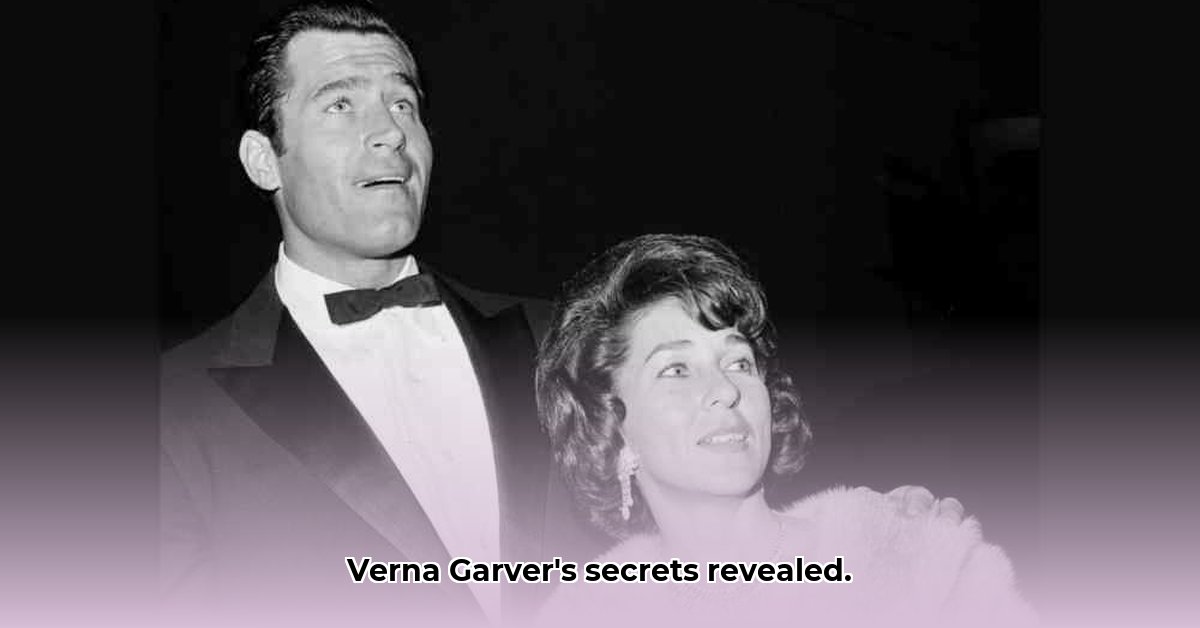Verna Garver – the name might not immediately ring a bell, but she was Clint Walker’s first wife. While she lived a life largely outside the spotlight, Verna’s story is compelling in its own right. This exploration aims to uncover what we know about her family background, her upbringing, her life with a Hollywood star, and the impact she had on those closest to her. We strive for honesty, acknowledging the limitations of available information, while sharing what can be discovered about this fascinating woman. For a more in-depth look, visit Verna Garver’s story.
Verna Garver Personal Life: A Life Beyond the Limelight
Who was Verna Garver beyond her connection to Clint Walker? She was a woman with a family, defined by quiet strength and untold stories deserving attention. This biographical narrative delves into the known facts while acknowledging the gaps in her documented history, striving to portray Verna as an individual. Let’s explore the life of Verna, a strong figure in her family and community.
A Life Mostly Unwritten: Early Years and Family
Verna Lucille Garver was born on April 16, 1927, in Anna, Union County, Illinois. Her parents were Jesse Albert Garver and Cuba Mabel (St. John) Garver. Details regarding her childhood remain scarce, a common challenge when researching private individuals. She had two older sisters, Vera Luella Garver West and Virginia Lee Garver Wallace, though even their exact birth and death dates are inconsistent across sources. These inconsistencies highlight the challenges of piecing together a complete picture of her early life. Like a jigsaw puzzle with missing pieces, we get a general outline, but not complete clarity. The search for accurate information requires patience and a dedication to verifying sources.
Vera Luella Garver was born on March 29, 1923, in Pennsylvania. She married Oscar John Beatty and had two daughters, Pamela Dawn and Vera Sue. She later divorced Beatty and married Lauren West. Vera passed away on September 24, 2014, in California. Virginia Lee Garver was born on November 11, 1924, and died on November 17, 2006, in California. She was the second wife of James Voiles Wallace, and they had two children, James Dana and Kimberly Diane.
What were Verna’s dreams? What experiences shaped her character? These remain unanswered questions. Understanding the limits of available information becomes crucial in appreciating the story we can piece together. This requires careful examination of available records.
Marriage, Motherhood, and a Daughter’s Triumph
Verna married Clint Walker on September 5, 1948, a union that lasted two decades. They had one child, Valerie, born in 1950, who became a successful airline pilot – a remarkable achievement for a woman in that era. It’s easy to imagine Verna’s pride in her daughter’s accomplishments, providing a glimpse into Verna’s values and the support she offered her family. While speculation is unavoidable, it’s likely that Verna’s support played a key role in shaping Valerie’s ambition. What kind of influence and encouragement did Verna offer to her daughter to achieve this remarkable feat?
Valerie Walker, also known as Captain Valerie Walker, became one of the first female airline pilots. She worked for Western Airlines and later Delta Airlines, retiring as a captain rated on the 727, 737, 757, and 767. She also became a martial arts instructor.
But what were Verna’s aspirations beyond her roles as wife and mother? The historical record remains unclear.
Beyond Homemaking: Unraveling an Incomplete Narrative
Verna is mostly portrayed as a homemaker, which was conventional for women of her generation. However, it’s crucial to question if this was the entirety of her identity, because the absence of professional details poses a problem for creating a complete biography. Homemaking itself was a significant and demanding role. Did she find fulfillment in dedicating herself to her family? The picture remains incomplete.
Like a portrait with missing sections, we only see parts of the picture. This necessitates a careful approach, relying on known facts and avoiding assumptions based on limited evidence, while respecting her privacy. Personal contributions and family life are equally important elements of a person’s life story.
The Detective Work of Biography: Challenges and Opportunities
Writing Verna’s biography is like detective work: piecing together fragments to create a holistic portrait. Even slight discrepancies in dates, such as those relating to her sisters, emphasize the difficulties of biographical research. Careful verification is a must, comparing accounts from multiple sources to identify inaccuracies. Access to personal letters, diaries, or family interviews would reveal a clearer picture, helping to fill the missing pieces, helping to fill in the blanks in learning how to find primary sources about Verna Garver. What we lack in concrete information, we can attempt to understand through context. The relative scarcity of primary source material makes piecing together Verna’s story a challenging but rewarding pursuit.
The Search Continues: Illuminating an Unsung Life
Further research is undeniably necessary. A more robust understanding of Verna Garver requires a deeper dive into historical records, interviews with family members (should that be possible), and the discovery of previously unknown documents or photos. Not only would this enrich our understanding of Verna’s life, but it would also benefit future biographical endeavours. The search to uncover Verna Garver’s Family Legacy: Unveiling Sister’s Lives and Ancestral Roots persists.
What we do know is that Verna Garver was a wife, a mother, and a woman who quietly shaped the lives of those around her. Her daughter’s achievement is a powerful testament to her influence, a legacy that deserves recognition.
A Quiet Legacy of Strength and Resilience
Verna Garver’s life illustrates that a life lived outside the public eye still deserves recognition and respect. Her story highlights the ways people shape the lives of others, even without fame. Verna’s quiet strength and her family’s achievements stand as a testament to the power of love, family, and resilience. Her story reminds us to value the contributions of those whose lives might have been largely unsung. While many questions remain unanswered, her legacy continues to resonate, urging us to seek out the untold stories of ordinary people who impact the world, revealing Verna Garver’s Resilience: Overcoming Challenges in Mid-20th Century Society.
How to Find Primary Sources About Verna Garver
Uncovering primary sources about Verna Garver may seem challenging given her preference for privacy. However, several strategies can be employed to potentially reveal more about her life.
Key Takeaways:
- Verna Garver’s chose to lead a private life, which makes finding information about her difficult.
- Existing sources provide basic details, but lack depth.
- Finding primary sources about Verna Garver requires proactive research.
- Family members might possess unpublished information.
- Archival research is crucial.
Unveiling the Enigma: Verna Garver’s Private Life
Verna Garver, Clint Walker’s first wife, remains a figure shrouded in mystery. Readily available information confirms key life events such as her birth, marriage, divorce, and death. The specifics of her life, however, remain elusive. How can we learn more? The answer lies in actively searching for primary sources about Verna Garver.
The Challenge of Limited Public Information
Most online resources offer only brief biographical details, which provide basic facts, but lack the richness for understanding Verna Garver as a person. This limited public record reflects her desire for privacy. Where can we look to learn more?
Strategies for Uncovering Primary Sources
To paint a fuller picture of Verna Garver’s life, we must explore beyond what’s easily found online.
- Family Connections: Contacting Verna Garver’s family, especially her daughter, Valerie Walker, might reveal untold stories, memories, and personal insights. Family photographs, letters, and diaries would be invaluable.
- Archival Research: Exploring relevant archives, including local libraries, state archives, and genealogical databases, may contain birth certificates, marriage records, death certificates, and other official documents. The FamilySearch website is a good starting point for genealogical research.
- Obituaries and Newspaper Archives: Searching newspaper archives from the relevant time periods might unearth more details about Verna’s life. Websites like Newspapers.com can be helpful. Her obituary was published in the Salt Lake Tribune.
- Local Historical Societies: Historical societies in Anna, Illinois (her birthplace), and Salt Lake City, Utah (where she died), often hold local records and oral histories that could provide unique perspectives on Verna Garver’s life within her community.
- Court Records: Divorce records, if accessible, might provide some insight into the circumstances surrounding her separation from Clint Walker.
The Importance of Ethical Considerations
When pursuing primary sources about Verna Garver, remember that ethical considerations matter. Respecting her privacy, even in death, is essential, and any information obtained should be handled responsibly.
Building a More Complete Narrative
Combining these sources will allow us to create a more nuanced and comprehensive biography of Verna Garver. Although the task may be challenging, the reward lies in understanding a remarkable woman beyond her existence as a Hollywood wife. It’s a quest for truth, respect, and the untold story of a life.
Verna Garver’s Family Legacy: Unveiling Sister’s Lives
- UPCI Missions Japan History: Lucas Family’s 30-Year Impact - July 20, 2025
- Uncover Verna Garver’s Impact on Missions: A Hidden Legacy Revealed - July 20, 2025
- Discover Verna Garver’s Legacy: A Quiet Strength - July 20, 2025













